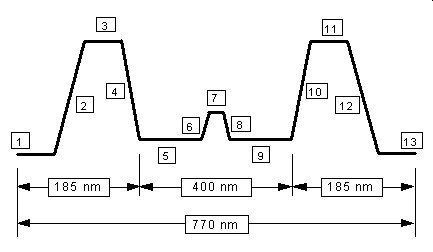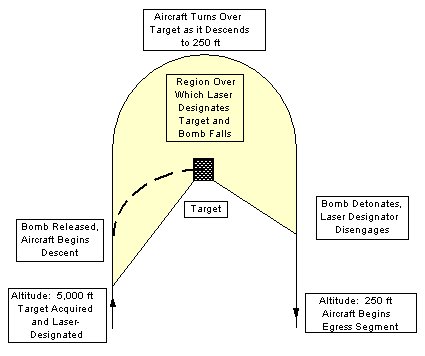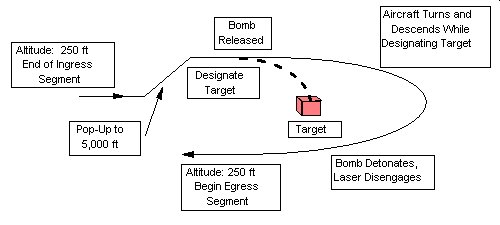|
||||||||||
|
|
||||||||||
|
||||||||||
|
|
||||||||||
|
|
|
||||||||||||||||||||||||||||||||||||||||||||||||||||||||||||||||||||||||||
|
Mission Profile:A conjectural profile of a bomb run mission (i.e. that with 200 NM ingress/egress segments) is shown below.

Attack mission profile
Attack Mission Profile
Though the profile is consistent with that of a manned military attack aircraft, much of the Storm Shadow's mission is similar to that of a cruise missile. Before takeoff, the flight computer would be pre-programmed with the flight path guiding it to and from the target area. The system operates using an onboard GPS navigation system similar to that fitted to the F-117 Nighthawk. (Refer to internal configuration for location of components.) Once airborne, the aircraft climbs to 40,000 ft to begin its first cruise segment (segment 3). Assuming a mission consisting of 200 NM ingress and egress segments (as specified in the RFP), the aircraft can travel a maximum of about 185 NM at 40,000 ft and Mach 0.7. At the end of the first cruise, the aircraft descends to 250 ft to begin the Mach 0.9 ingress segment (segment 5). A pilot at a ground station would likely take command of the aircraft once it is within 10 NM of the target giving him time to survey the combat environment. The ground station uses a VHF high-speed data link to communicate with the aircraft through an onboard antenna. To acquire the target with the FLIR, the pilot would probably need to perform a pop-up maneuver bringing the aircraft to about 5,000 ft, as indicated in the diagrams below. The target can then be highlighted with the laser designator.

Bomb drop (top view)

Bomb drop (isometric view)Once within approximately one NM of the target, the bomb bay doors would open to release the payload. While this action greatly increases the RCS of the aircraft, the doors are only open for a few seconds. However, it is possible that the enemy would be able to track the aircraft electronically once alerted to its presence. To reduce the probability of being tracked, the Storm Shadow should alter course and reduce altitude to hide in the ground clutter. By turning the aircraft over the target area, the laser can continuously designate the target as it drops back to 250 ft. After impact, the pilot may choose to sweep over the area again to assess damage before returning the aircraft to computer control. The aircraft returns to base using the GPS pre-programmable system already discussed. If the aircraft should lose communications with the ground station, the aircraft could be pre-programmed with proper contingency instructions as done on the Predator UAV. If communications are lost during the bomb drop, the mission would likely have to be aborted. The aircraft would then progress to the egress segment under computer control. |


|
Aircraft | Design | Ask Us | Shop | Search |

|
|
| About Us | Contact Us | Copyright © 1997- | |||
|
|
|||